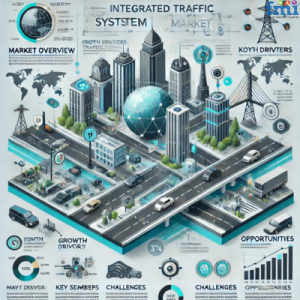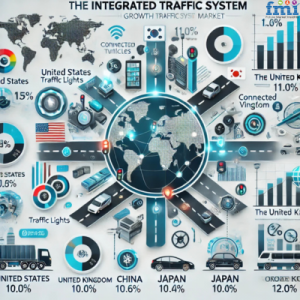Robust Growth Ahead: Integrated Traffic Systems Market to Hit USD 94.0 Billion with a CAGR of 9.8% by 2034 | FMI
The Integrated Traffic System Market is growing, driven by urbanization, smart city initiatives for efficient, safe, and sustainable traffic management.
NEWARK, DE, UNITED STATES, January 23, 2025 /EINPresswire.com/ -- The integrated traffic system market is projected to reach USD 36.9 billion in 2024 and is expected to grow to USD 94.0 billion by 2034, with a compound annual growth rate (CAGR) of 9.8% during the forecast period from 2024 to 2034.Key Industry Insights: Integrated Traffic System Market
Market Growth and Forecast: The integrated traffic system market is poised for substantial growth, projected to reach USD 36.9 billion in 2024 and expand to USD 94.0 billion by 2034. The market is set to grow at a robust CAGR of 9.8% during the forecast period (2024-2034), driven by urbanization, government regulations, and technological advancements.
Urbanization Driving Demand: Rapid urbanization and increasing traffic congestion in major cities around the world are creating a significant demand for integrated traffic solutions. These systems enable real-time traffic monitoring, dynamic signal management, and optimized route planning, contributing to reduced congestion, fuel consumption, and air pollution.
Government Regulations and Infrastructure Investment: Government initiatives aimed at improving road safety, reducing accidents, and optimizing transportation infrastructure are driving the adoption of integrated traffic systems. Many countries are prioritizing smart city development, with traffic management systems being an essential component of these initiatives.
Autonomous and Connected Vehicles: The rise of autonomous vehicles and connected car technologies presents significant opportunities for integration with intelligent traffic management systems. V2X (Vehicle-to-Everything) communication allows vehicles to communicate with traffic signals, other vehicles, and infrastructure, leading to safer and more efficient road networks.
Public-Private Partnerships: Increasing collaboration between public entities, private companies, and research institutions is fostering innovation in the market. These partnerships are crucial in the development of advanced traffic management solutions, enabling the implementation of cutting-edge technologies in urban areas.
Detailed Market Study: Full Report and Analysis
https://www.futuremarketinsights.com/reports/integrated-traffic-system-market
Key Market Drivers:
Urban Traffic Congestion: Traffic congestion remains a pressing issue in many cities globally, causing productivity losses, heightened fuel consumption, and increased pollution. Integrated traffic systems are emerging as a comprehensive solution to alleviate these problems, offering enhanced traffic management, signal optimization, and route planning.
Government Initiatives: Governments worldwide are increasingly focused on improving road safety, reducing accidents, and upgrading transportation infrastructure. With regulations promoting these objectives, the adoption of integrated traffic systems has accelerated as part of national and regional initiatives.
Technological Advancements: The emergence of connected and autonomous vehicles presents new opportunities for the integration of these vehicles into intelligent traffic management systems. This convergence of autonomous technology and traffic management promises safer, more efficient transportation networks.
Public-Private Collaboration: A rise in collaborations between governments, private companies, and research institutions is fostering innovation in the integrated traffic systems sector. These partnerships are driving significant investment, encouraging the development of cutting-edge solutions that enhance urban mobility.
Key Market Trends and Insights
Urban traffic congestion is a major issue, resulting in productivity losses, higher fuel consumption, and increased air pollution. Integrated traffic systems provide solutions to alleviate congestion through enhanced traffic management, optimized signal systems, and effective route planning.
Government policies and regulations focused on improving road safety, reducing accidents, and enhancing transportation infrastructure are driving the adoption of integrated traffic systems.
The rise of connected and autonomous vehicles creates opportunities for their integration into traffic management systems, contributing to safer and more efficient transportation networks.
Collaboration between governments, private enterprises, and research organizations is promoting innovation and investment in integrated traffic systems, fueling market growth.
Key Trends and Innovations in the Integrated Traffic System Market
Smart Traffic Management: One of the most significant trends is the adoption of smart traffic management systems that leverage real-time data, AI, and machine learning. These systems are capable of dynamically adjusting traffic signals, optimizing traffic flow, and providing real-time updates to drivers, improving efficiency and reducing congestion. AI-based solutions predict traffic patterns, helping authorities respond proactively to traffic disruptions.
Vehicle-to-Everything (V2X) Communication: The rise of connected vehicles is driving the integration of Vehicle-to-Everything (V2X) technology into traffic systems. V2X enables vehicles to communicate with traffic signals, other vehicles, and surrounding infrastructure, allowing for better traffic flow, reduced accidents, and more efficient use of road networks. This communication will be crucial for the integration of autonomous vehicles in urban environments.
Autonomous Vehicle Integration: As autonomous vehicles become more prevalent, their integration with integrated traffic systems is crucial for ensuring safety and efficiency on the roads. Autonomous vehicles will interact with traffic management systems, allowing for smoother transitions at intersections, safer pedestrian crossings, and coordinated vehicle movements. This will reduce human error and enhance overall traffic safety.
Use of Artificial Intelligence and Big Data: AI and big data analytics are being increasingly utilized to process large volumes of traffic-related data. This enables cities to optimize traffic signals, predict congestion, and offer real-time traffic guidance to drivers. AI systems can analyze patterns from various sources, including cameras, sensors, and traffic flow data, and generate actionable insights for city planners and traffic authorities.
Cloud-Based Traffic Systems: The shift towards cloud-based integrated traffic systems is a growing trend, allowing for greater scalability and flexibility. Cloud technology enables the centralized management of traffic data and systems, allowing city planners to access real-time data and monitor traffic conditions from anywhere. This also allows for faster updates and easier system upgrades, improving overall system performance.
Vehicle Safety and Technology: Enhancing Driver Protection
https://www.futuremarketinsights.com/industry-analysis/automotive-smart-and-connected-technologies
Regional Insights in the Integrated Traffic System Market
North America:
Strong adoption of smart city initiatives and government support for advanced transportation solutions.
Growing demand for efficient traffic management solutions due to high urbanization and congestion in major cities.
Significant investment in AI, IoT, and V2X technologies for enhanced traffic flow and safety.
Europe:
High focus on sustainability and green transportation, with integrated traffic systems playing a key role in emission reduction.
Robust government regulations supporting the development of intelligent traffic management and road safety solutions.
Expansion of smart city projects, particularly in countries like the UK, Germany, and France.
Asia-Pacific:
Rapid urbanization, increased vehicle ownership, and traffic congestion are driving the demand for integrated traffic solutions.
High government investments in smart cities and advanced traffic infrastructure, especially in China, Japan, and India.
Emerging opportunities due to the integration of autonomous vehicles and connected technologies in urban traffic systems.
Middle East & Africa:
Significant infrastructure development, with countries like the UAE investing heavily in smart transportation technologies.
Growing demand for integrated traffic systems in major urban centers to address congestion and improve traffic management.
Increasing government initiatives aimed at improving road safety and optimizing transportation networks.
Latin America:
Rising urbanization and traffic challenges in countries like Brazil and Mexico are driving the adoption of intelligent traffic management solutions.
Limited yet growing investments in smart city projects and integrated traffic systems to improve road safety and reduce congestion.
Increased focus on public-private partnerships for technology innovation in urban mobility.
Competitive Landscape
The competitive landscape of the integrated traffic system market is characterized by the presence of several key players, each offering a range of solutions and services aimed at optimizing traffic flow, enhancing road safety, and improving transportation efficiency. imtac; Savari Inc; Thales Group; TransCore; EFKON India; Iteris Inc; Cubic Corporation; Intelvision Technologies Limited; Nuance Communication Inc; Citilog; Kapsch TrafficCom AG
The market encompasses a variety of integrated traffic management systems, including hardware components, software platforms, and service offerings designed to address the evolving needs of urban transportation networks worldwide.
Segmentation Analysis of the Integrated Traffic System Market
By Function:
Traffic Monitoring
Traffic Control
Information Provision
By Hardware Type:
Display Boards
Sensors
Radars
Interface Boards
Surveillance Cameras
By Sensors:
Infrared Sensor
Weigh in Motion Sensor
Acoustic Sensor
Others
By Application:
Urban Traffic
Expressway
By Region:
North America
Latin America
Western Europe
Eastern Europe
South Asia and Pacific
East Asia
The Middle East and Africa
Have a Look at Related Research Reports on Automotive
The global traffic sign recognition system market is projected to grow at a CAGR of 3.5%, from USD 37.81 Million in 2022 to USD 53.34 Million in 2032.
The global automotive connectivity market is projected to register at a moderate-paced CAGR of 19% over the forecast period.
About Future Market Insights (FMI)
Future Market Insights, Inc. (ESOMAR certified, recipient of the Stevie Award, and a member of the Greater New York Chamber of Commerce) offers profound insights into the driving factors that are boosting demand in the market. FMI stands as the leading global provider of market intelligence, advisory services, consulting, and events for the Packaging, Food and Beverage, Consumer Technology, Healthcare, Industrial, and Chemicals markets. With a vast team of 400 analysts worldwide, FMI provides global, regional, and local expertise on diverse domains and industry trends across more than 110 countries.
Join us as we commemorate 10 years of delivering trusted market insights. Reflecting on a decade of achievements, we continue to lead with integrity, innovation, and expertise.
Contact Us:
Future Market Insights Inc.
Christiana Corporate, 200 Continental Drive,
Suite 401, Newark, Delaware - 19713, USA
T: +1-347-918-3531
Website: https://www.futuremarketinsights.com
Ankush Nikam
Future Market Insights, Inc.
+91 90966 84197
email us here
Visit us on social media:
Facebook
X
LinkedIn
YouTube
Legal Disclaimer:
EIN Presswire provides this news content "as is" without warranty of any kind. We do not accept any responsibility or liability for the accuracy, content, images, videos, licenses, completeness, legality, or reliability of the information contained in this article. If you have any complaints or copyright issues related to this article, kindly contact the author above.


